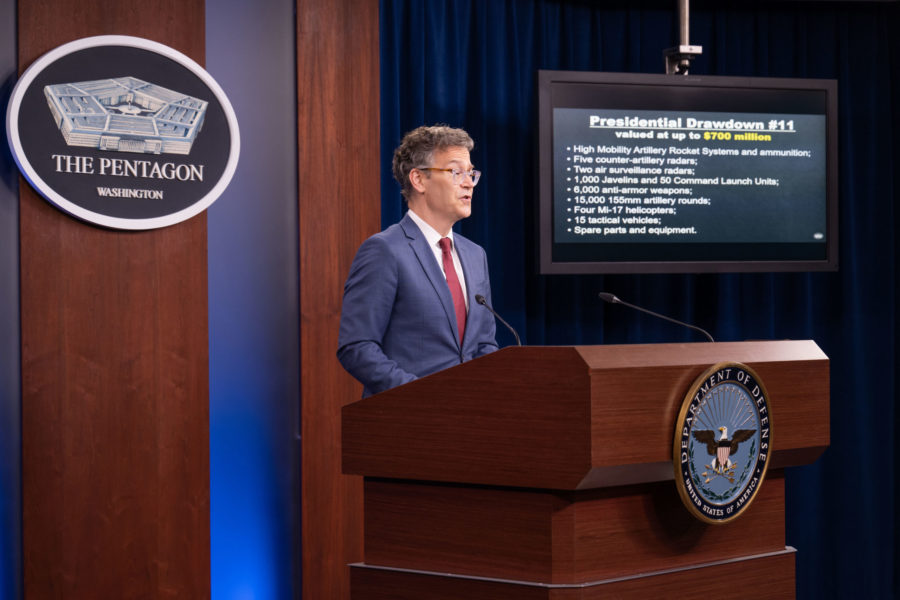The Pentagon announced its latest drawdown package for Ukraine on Aug. 8, valued at $1 billion and mainly comprising munitions for key systems. But any decision on whether to provide the Ukrainian Air Force with Western combat jets is still to be made, a key Defense Department official told reporters—and it could potentially take “a year to three years” before such jets could be delivered.
Undersecretary of Defense for Policy Colin Kahl’s comments came several weeks after top U.S. Air Force officials indicated an openness to giving Ukraine some kind of fighter aircraft in its fight against Russia’s invasion, seemingly reversing previous opposition to such a move.
But Kahl didn’t say which aircraft the U.S. might give to the Ukrainians and noted that actually getting them to Ukraine wouldn’t happen quickly and therefore was not an immediate priority.
“Our overwhelming priority right now is getting the Ukrainians things that are relevant for the current fight. So right now, the fight is in the east and increasingly in the south. We need to get them capabilities that deliver on a timeframe that’s relevant to that,” Kahl said. “So we’re focused on these types of capabilities, not something that might deliver in a year to three years, etc.
“That said, there is work being done here at the Pentagon and elsewhere out in Europe at EUCOM … to help work with Ukrainians to identify their medium- to long-term requirements. So think of things that aren’t measured in days and weeks but measured in the months and a handful of years.”
Specifically, “there are real questions about what would be most useful in terms of assisting the Ukrainian Air Force in improving its capabilities,” Kahl said. “It’s not inconceivable that down the road, Western aircraft could be part of the mix on that. But the final analysis has not been done.”
While the Pentagon considers the delivery of Western jets to be a longer-term priority, Ukrainian officials have been pushing for them for several months, and pilots have told Air Force Magazine that sorites in their outperformed MiG-29s now are essentially “suicide missions.”
In particular, Ukraine has said it needs “fast and versatile” aircraft such as the F-16, not slower-moving ground defense platforms such as the A-10. The Ukrainians have also pushed for their pilots to start receiving training on Western aircraft as soon as possible, even before a final decision is made on which aircraft to give them.
Members of the U.S. House of Representatives have lent their support on that last point, including a provision in their version of the 2023 National Defense Authorization Act that would provide $100 million for Ukrainian pilots to train on American fixed-wing aircraft. That legislation, however, has yet to pass the Senate.
Munitions and Missiles
In the meantime, the Pentagon continues to announce new Presidential drawdowns of security aid for Ukraine—Aug. 8’s package is the 18th in the past year. And this latest one is primarily composed of missiles and ammunition for artillery, mortar systems, High Mobility Artillery Rocket Systems (HIMARS), and National Advanced Surface-to-Air Missile Systems (NASAMS).
What the package did not include was any new HIMARS or NASAMS. Ukrainian officials have said they need rapidly expanded numbers of HIMARS from their current inventory of 16, as well as quick delivery of NASAMS to defend against the Russian cruise missile threat.
But while the Pentagon is providing an unspecified number of Guided Multiple Launch Rocket Systems (GMLRS) to be fired from the HIMARS, “our assessment actually is that the Ukrainians are doing pretty well in terms of the numbers of systems and really the priority right now is making sure that they have a steady stream of these GMLRS,” Kahl said.
The GMLRS are having “real operational effects,” Kahl added.
“These GMLRS … are having a very profound effect. I mean, this is a 200-pound warhead. It’s kind of the equivalent of an airstrike, frankly, a precision-guided airstrike,” Kahl said. “These are GPS-guided munitions. They’ve been very effective in hitting things that previously the Ukrainians had difficulty hitting reliably.”
In terms of air defenses, the new drawdown includes an unspecified number of Advanced Medium-Range Air-to-Air Missiles (AMRAAMs) that will go with the NASAMS, Kahl clarified.
“There are no NASAMS in this package. There are AMRAAM missiles for the NASAMS. So the NASAMS that are in the pipeline, we think, will probably arrive in the next few months,” Kahl said. “And the AMRAAM missiles that are in this system, which can be used for the NASAMS, they will take some period of [time]. … They’ll have to be looked at, the inventory has to be looked at, to make sure that all the missiles are in good shape, and then they’ll get there in time for the NASAMS’ arrival.”
